Beginner's Guide to Rich Snippets for SEO
28 July 2020

The complete beginner's guide to rich snippets and why they're good for SEO.
It’s no secret that how your website appears in a search engine is crucial to success. If you aren’t providing enough information about who you are and what you do through SEO efforts, you’re going to see your click-through rates impacted and you won’t rank as high on Search Engine Results Pages (SERPs).
This is where rich snippets come in, they can transform how your pages appear on SERPs as they provide extra information in addition to your default page description. In this article, we will be offering a complete beginner’s guide to rich snippets, they may not have a direct impact on SEO, but we will explain why they’re important for your business.
Snippets are the page descriptions that you see on search engine results pages and there are ways in which these results can be enriched. As standard, a page’s search engine snippet is going to display its title, URL and description. Here’s an example below:

To achieve enriched results, you need to use structured data. Structured data is described by Google as a standardised format for providing information about a page and classifying the content.
When Google begins crawling the web and structured data is present, it can use that data to create rich snippets. The more information you can provide Google with, the better! This ‘rich’ information can come in the form of images, authors, locations, ratings and more.
Publishers give Google these details by including the structured data in the backend of webpages. Check out this example for a cookie recipe:
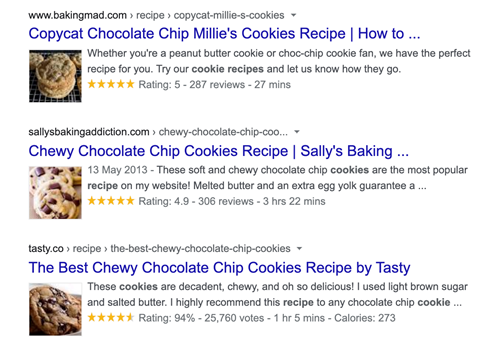 Here we can see a rating, how many reviews or votes the rating is based on and prep time. The more information included; the more likely users are to click on the result. So, if someone is looking for a cookie recipe that is quick and easy, they can already see this information before they even click the link.
Here we can see a rating, how many reviews or votes the rating is based on and prep time. The more information included; the more likely users are to click on the result. So, if someone is looking for a cookie recipe that is quick and easy, they can already see this information before they even click the link.
The term rich snippets is often used interchangeably with different terms like rich results, structured data, schema, and micro data which is confusing for an SEO beginner. Many articles out there will state they’re the same thing, other’s will say they’re all completely different. So, lets clear this up by breaking it down into 2 sections - what are rich results and what is structured data.
The term rich results refers to any type of visually enhanced search result that has information being pulled from relevant structured data. If you visit Google’s search gallery, you will see the terms rich results and rich snippets being used and this lack of consistency in terminology only causes more confusion.
Rich results are designed to highlight key information and help search engine’s understand a page’s purpose as accurately as possible. This means less guesswork for Google, more relevant results for users and a well optimised snippet for SEO. Rich results are the actual features that appear on SERP pages.
Here is a table showing 16 SERP features that commonly appear in Google SERPs.
|
Featured Snippets |
Sitelinks |
Adwords Top |
Adwords Bottom |
|
Videos |
Local Packs |
Image Packs |
Twitter Packs |
|
In-depth Articles |
Reviews |
Shopping Results |
Search Boxes |
|
Knowledge Panels |
Related Questions |
Local Teaser Pack |
News Boxes |
These SERP features have played a huge rule in the evolution of SEO. They have added nuanced ways to disperse information for different audiences and gives businesses that aren’t industry leaders the chance to build awareness and drive traffic. By optimising the site in line with the certain guidelines, you can put your website on prime SERP real-estate to drive traffic and get people to your business.
Like we have mentioned above, rich snippets are regular search results with additional information displayed alongside the snippet, title and URL. They are a type of rich result and in order to achieve rich results, you need to add structured data to the backend of your webpage.
Structured data is a type of code that makes it easier for search engines to crawl, organise and display content and is also known as schema markup.
The term schema markup comes from schema.org and is a collaboration project between the search engines Google, Bing, Yandex and Yahoo. Schema is the agreed vocabulary for structured data that helps all search engines understand the context of content on a webpage.
The schema.org vocabulary includes formats for structuring data arounds all kinds of things on the web. If you want to know the full list of items that schema markups can define, you can find it on their website. Some examples of schema are:

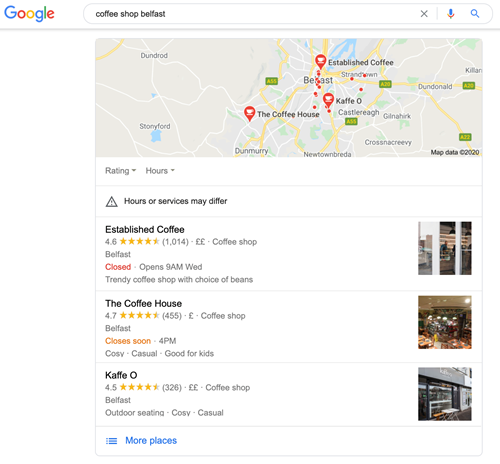
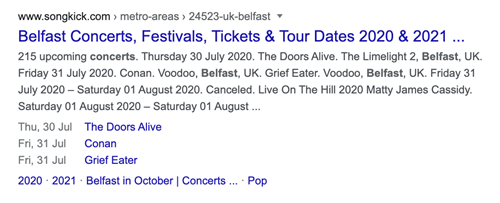
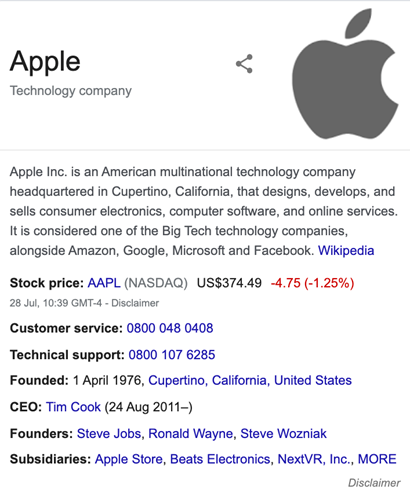


By applying schema markup, you are telling search engines what your content relates to and in turn, it helps the search engine match search intent and displays the relevant content to users. Google will support structured data in the following formats:
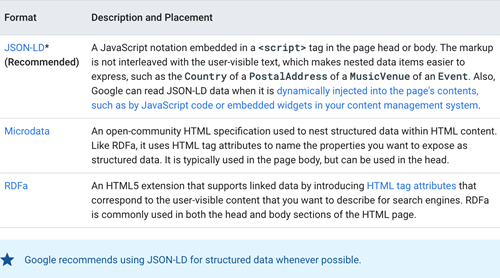
There is no direct impact on SEO (keyword being direct). However, while structured data mark-up for rich snippets isn’t considered to be a ranking signal, it can generate SEO benefits as it will make your page more easily indexable due to providing more targeted and accurate meta data.
With this follows on page behavioural data such as your click-through rate and time on site, which have an impact on your rankings. By adding that data you can gain higher user engagement, higher rankings and more traffic. In other words – successful SEO!
You’re also taking the guesswork out of your website and making your site more relevant. Rich snippets can promote trust in your site, making visitors more inclined to choose you over the next result.
The first step to achieving any form of rich result is to understand where you should add structured data within your website’s HTML and on what information. Take your time to research and outline strategies for using them that will help drive traffic to your site.
For implementation, you will likely need help from a developer, and once that’s completed you need to check your rich result/structured data application with Google’s Rich Results Test. If everything is implemented correctly, all you need to do is sit back and wait for the results!
On the 7th July 2020, Google announced that the Rich Results Test now fully supports all Google Search rich results features, meaning it’s out of beta. So, it’s out with the old Structured Data Testing tool and in with the new! The Structured Data Testing tool can still be used for the time being, but it won’t be long until it’s gone.
The Google Rich Results Test debuted back in 2017 and at the time was an upgrade for the Structured Data Testing Tool which launched back in 2015. The Rich Results Test offered support for just four types of data which were:
Before this update, users would have bounced between the two, but now the Rich Results Test now has all the features it needs to make it reliable for testing both your website’s structured data and rich results.
All types of mark-ups that Google search results also support can now be tested on the updated tool which is a substantial upgrade from the previous tool. Just like the Google Structured Data Testing tool, it offers publishers the ability to test an isolated code snippet or a whole page URL. Some other advantages of the update are:
If you want to know more about how to use the tool, Google has provided full documentation on this.
There are many ways you can highlight what matters most to your potential visitors, but doing so doesn’t guarantee that you’ll immediately move to first place or your CTR will increase by 200%. But it does make you more visible. Like we mentioned above, it will make you stand out from the rest and it can work to improve your CTR and bounce rates.
If you want to discuss all things SEO and implementing rich snippets for your business, get in touch with Loud Mouth today!